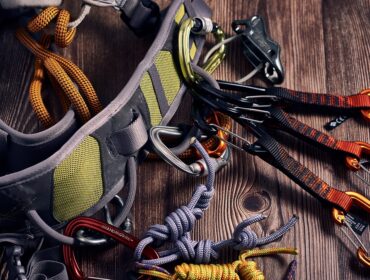Whether you’re hiking deep into the wilderness or observing wildlife from a scenic trail, a dependable pair of binoculars enhances every detail. From the shimmer of a bird’s plumage to the quiet motion of a deer in the brush, the right optics can make the difference between a passing glimpse and a memory etched in clarity. At SunnySports.com, you’ll find a strong selection of binoculars designed for these moments – rugged, weather-resistant, and sharp-eyed like the wildlife you seek to admire. Here’s our curated guide to the best binoculars for wildlife watching and hiking, all available from SunnySports.
1. Celestron 8×42 TrailSeeker Roof Prism Binocular

Model: 71404
Weight Class: Midweight
Magnification & Field of View: 8×42; 8.1° angle of view
Why It’s Great:
The TrailSeeker 8×42 is a well-balanced choice that excels in image brightness, clarity, and comfort. Built with BaK-4 prisms and fully multi-coated optics, it delivers crisp images in various light conditions – ideal for dawn hikes or shaded forest trails. The ergonomic body design ensures prolonged viewing without strain, while its waterproof build handles unpredictable weather with ease.
Best For: Intermediate hikers and bird watchers looking for quality without overcomplicating their gear setup.
2. Celestron 10×42 Nature DX Roof Prism Binocular

Model: 71333
Weight Class: Lightweight
Magnification & Field of View: 10×42; 5.8° angle of view
Why It’s Great:
If you prioritize magnification for distant subjects, this model hits the mark. The Nature DX 10×42 offers long-range visibility while staying compact enough to wear around your neck during hikes. It uses BaK-4 prisms and multi-coated optics, delivering vibrant color and contrast. Its durability and waterproofing make it suitable for variable terrain and sudden weather shifts.
Best For: Long-range wildlife observation and hikers who like lightweight gear.
3. Vortex Optics 12×50 Diamondback HD Roof Prism Binocular

Model: DB-217
Weight Class: Full-size
Magnification & Field of View: 12×50; 5.2° angle of view
Why It’s Great:
The Vortex Diamondback HD 12×50 is engineered for powerful magnification without sacrificing edge-to-edge clarity. With HD optics, waterproof/fog-proof performance, and a durable rubber armor coating, this model thrives in rugged environments. It’s heavier than smaller models but offers stunning detail at a distance – a huge benefit when observing animals in expansive landscapes.
Best For: Wildlife tracking in open terrain, national parks, or spotting distant animals like elk or birds of prey.
4. Celestron 8×32 Nature DX Binocular

Model: 71330
Weight Class: Ultra-lightweight
Magnification & Field of View: 8×32
Why It’s Great:
This is a great compact option for those who want performance and portability. The Nature DX 8×32 is a reliable companion on hikes, with enough magnification for close encounters and quick-glance wildlife watching. Its weather resistance, multi-coated lenses, and lifetime limited warranty make it ideal for beginner hikers or light travel.
Best For: Day hikers, backpackers, and eco-tourists looking for a travel-friendly choice.
5. Celestron 10×42 Regal ED Roof Prism Binocular

Model: 71391
Weight Class: Mid-heavy
Magnification & Field of View: 10×42
Why It’s Great:
The Regal ED series is Celestron’s answer to premium optical clarity at a reasonable price. With extra-low dispersion (ED) glass, this binocular reduces chromatic aberration and enhances true-to-life color. The nitrogen-filled waterproof design guarantees reliability, while the rugged frame supports long treks.
Best For: Advanced users, photographers, or wildlife watchers focused on image fidelity.
6. Celestron 12×56 Nature DX Roof Prism Binocular

Model: 71336
Weight Class: Full-size
Magnification & Field of View: 12×56; 5.5° angle of view
Why It’s Great:
For hikers and watchers who need extra reach, this model’s 12x magnification is powerful. The 56mm objective lens gathers more light, making it excellent for low-light conditions like early mornings or overcast days. It’s slightly bulkier, so it’s best paired with a shoulder harness or tripod mount for extended viewing.
Best For: Experienced hikers or wildlife researchers who prioritize long-distance clarity.
7. Celestron 12×50 Nature DX ED Roof Prism Binocular

Model: 72336
Weight Class: Full-size
Magnification & Field of View: 12×50
Why It’s Great:
Combining ED glass with a large 50mm lens, this Nature DX ED model is one of the most versatile binoculars for varied lighting. You get enhanced color accuracy, sharp contrast, and wide coverage – all with a durable, waterproof build.
Best For: High-contrast wildlife viewing in mixed lighting conditions.
8. Celestron 25×70 SkyMaster Porro Prism Binocular

Model: 71008
Weight Class: Heavy-duty
Magnification & Field of View: 25×70
Why It’s Great:
While less suited for hikes due to its weight, the SkyMaster 25×70 excels at stationary wildlife observation, such as from a viewing platform or basecamp. It provides extremely detailed, high-powered magnification and is tripod adaptable for steady long-range views.
Best For: Stationary wildlife watching, night-sky viewing, and basecamp observation.
Choosing the Right Binoculars for Your Needs
When selecting binoculars for hikes or wildlife watching, consider:
-
Magnification (8x-12x): 8x is great for wide-field scanning; 10x-12x is better for long-range detail.
-
Objective Lens Size (32mm-56mm): Larger lenses gather more light but add weight.
-
Waterproofing: A must-have for trails with unpredictable weather.
-
Weight and Ergonomics: Lightweight models are easier to carry; ergonomic designs reduce fatigue.
-
Glass Quality: ED or HD glass reduces distortion and improves brightness.
Final Thoughts
A good pair of binoculars should feel like a natural extension of your senses – revealing details that the naked eye can’t capture. The options available at SunnySports.com cater to casual birders, rugged trekkers, and seasoned wildlife photographers alike. With waterproofing, ergonomic grips, and precision optics built into every model, these binoculars are trail-ready companions for every nature lover.
So, whether you’re scanning a tree line for a red-tailed hawk or watching elk cross a distant ridge at sunset, the right binoculars will keep you connected to the wild – one crisp, clear view at a time.
FAQs: Wildlife Watching and Hikes
What magnification is best for wildlife watching?
8x to 10x magnification is ideal for most wildlife viewing. It offers a wide enough field of view to track movement and provides sufficient detail without excessive hand shake.
Are higher magnification binoculars better for hiking?
Not always. While 12x or 25x models offer more detail, they are heavier and harder to stabilize. For hiking, compact 8×42 or 10×42 models are more practical.
What do the numbers like 8×42 or 10×50 mean?
The first number (e.g., 8x) is magnification power; the second number (e.g., 42mm) is the objective lens diameter, which affects light-gathering ability and image brightness.
What features should I look for in hiking binoculars?
Look for lightweight, waterproof, and fog-proof designs with rubberized armor for grip. Multi-coated lenses and BaK-4 prisms ensure clear, bright images.
Can I use these binoculars in rainy or foggy conditions?
Yes. Most models on SunnySports like the Celestron TrailSeeker and Vortex Diamondback are waterproof and fog-proof, suitable for all-weather use.





